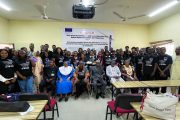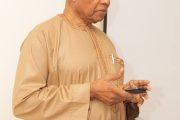There is a sense in which this book can be understood as an Early Warning even as probably the clumsiest Cold War grammar that Early Warning is. The temptation to regard the book as such would appear self-evident, what with the categorical pronouncements and discursive data it has amassed, all foretelling what could happen to the society should it mismanage what Marxists would call the Youth Question in the similar manner that they gave us the Women Question, the Land Question, the National Question. The most daring formulation of the Youth Question might be Kassim Shettima, the governor of Borno State who is quoted on page 14 as saying “If we don’t take care of the youths today, they will certainly take care of us tomorrow”. He should know because the youths in his state are already taking care of Nigeria in the most violent manner imaginable via a Jihadist insurgency that is interrogating Nigeria.
 In other words, we can say that this is not just another book for the good reason that intellectuals of the ‘Ibadan School of Peace Studies’ are on the march on a theme in contemporary conflict studies which has attracted the attention of Nigerian statesmen, the policy mill and the International Financial Institutions, particularly the World Bank. How to contain the threat from the youth component of the society who feel disempowered on account of generational practices of inclusion and exclusion has simply registered in public policy. So, when the University of Ibadan which has the foremost knowledge production centre on conflict takes up such a question, it is inherently inviting. The University of Ibadan of today may not be compared to the University of Ibadan of 30 years ago. Even then, Ibadan can still be argued to retain its primacy in many respects, still not challengeable in several aspects of university governance and content. The editors of the book are among the most involved in Peace scholarship in Nigeria. If we pick Prof Isaac Olawale Albert from the three, for instance, he certainly is a study in methodology on account of being a trained Historian; a repository of the process of establishing Peace Studies and a researcher in the domain.
In other words, we can say that this is not just another book for the good reason that intellectuals of the ‘Ibadan School of Peace Studies’ are on the march on a theme in contemporary conflict studies which has attracted the attention of Nigerian statesmen, the policy mill and the International Financial Institutions, particularly the World Bank. How to contain the threat from the youth component of the society who feel disempowered on account of generational practices of inclusion and exclusion has simply registered in public policy. So, when the University of Ibadan which has the foremost knowledge production centre on conflict takes up such a question, it is inherently inviting. The University of Ibadan of today may not be compared to the University of Ibadan of 30 years ago. Even then, Ibadan can still be argued to retain its primacy in many respects, still not challengeable in several aspects of university governance and content. The editors of the book are among the most involved in Peace scholarship in Nigeria. If we pick Prof Isaac Olawale Albert from the three, for instance, he certainly is a study in methodology on account of being a trained Historian; a repository of the process of establishing Peace Studies and a researcher in the domain.
This is the team that is arguing that youths are contending with “a system where the old dominate and control the political and decision-making machinery”, (p. ix). and they are demonstrating the crisis of youth exclusion in Nigeria, a crisis that is, arguably, most signified by the fact that youth leaders of most of the political parties, for instance, are not youths because they are mostly above 40 years of age.To make matters worse, quality education which would have directed collective youth energy into innovation and forward looking practices is denied. The quality of university education is such that most graduates are unemployable. The inference is that there is a strategy of disempowerment in the undermining of university education because there was a time Nigerian universities were second to none across the world. The outcome of the current crisis of education is such that the youths are not groomed to be capable of qualitative as opposed to quantitative participation. According to this book, the next thing is the youths are operationalizing a number of self-help options.

A July 8th, 2017 AFP/Getty image of illegal African migrants marching into a detention centre in a risky journey to Europe
Those who are skilful and can get visa experiment migrating outside Nigeria. Those who are not try to achieve the same thing through the Mediterranean but with many of them perishing in the process, including being sold as slaves somewhere in Libya. Yet another set of the youths take to criminality – kidnapping, armed robbery and thuggery. There is the last set who take to drunkenness or drugs. Hence the logic of the argument of the authors that youths are contending with a system of domination or the hegemony of gerontocracy.
Interestingly, this is an informed standpoint if the testimonies to that effect are anything to go by. From General Ibrahim Babangida (IBB) to Dr. Goodluck Jonathan to Senator Dino Melaye, it is all admission of failure by the gerontocratic order. IBB probably put it best, going by the quotation on page 5 of the book: The older generation must give way for the new one. We have become analogue but this is a digital age; so, the young people should be supported to use their digital knowledge to move the country forward”. The question is, how can they move the country forward when they have been disempowered, through the poverty of current educational instructions and the exclusionary practices of power?
It is in this context that the authors, especially in The Preface and in the Introduction compare the youths’ struggle for power with women’s struggle for power. That comparison takes the book to a completely different realm of reminding all students of contemporary or 21st century society – industrial and even pre-industrial ones such as Nigeria of the phenomenon of fragmentation and the difficulty of sustaining the doctrine of class as the cornerstone of emancipation. With practitioners of gender, youths, ethnicity, religion and the environment framing the world differently, the idea of a ‘Historic Block’ appears more realistic that the idea of class struggle in its classical Marxist sense. But that is just a minor diversion here.
So, what is to be done? The authors are very categorical that the trouble is with quality of leadership in Nigeria. They think that the youth bomb might not have emerged or can only be diffused by leadership typified by late Singaporean Prime Minister, Lee Kuan Yew; Sheikh Rashid and his transformative touch in the United Arab Emirate symbolized by the magic of Dubai; President Paul Kagame in Rwanda who has taken his country from a genocide straight to modernity. The billion Naira question the three of the multiple authors who wrote the Introduction have posed is: How does Nigeria produce such forward-looking leaders?

Dr Benjamin Aluko, IPSS-UI and the author of a chapter in the book

Dr. Nathaniel Danjibo, another Ibadan voice and author of another chapter in the book
This is how far one can go in terms of the key argument of the book because it is actually a compendium by so many authors, each one with his or her analytical bent. Beyond that, the generational thing also comes up here too: there are the established names as well as emerging voices in peace scholarship in Nigeria – the Danjibos, Benjamin Alukos, Chris Kwajas just as there are doctoral candidates stepping out in the book. It is the divergent voices that one hears as one roams through the four different sections into which the 18-chapter book is divided, one section flowing into the next. It is certainly a very rich book, with almost every dimension of the youth bomb taken up. Most readers would find the chapter on youth instrumentalisation of the social media entertaining but equally serious. There is a conclusion there that youth utilization of the social media space is not all hate speeches and lurid details. It is a conclusion that would most likely attract the attention of anti-hate speech warriors such as Kano based Centre for Information Technology and Development, (CITAD). Similarly inviting is the chapter which studied Senators Dino Melaye and Shehu Sani as models of political youth, Melaye being 44 and Sani being 50. An experienced academic and a peace practitioner cum politician in the person of DrAdeoluAkande takes the reader through what money does to the youths in relation to political violence. The question of how far something like Not Too Young to Run goes is a subject of a chapter too.Two chapters tried to see what the corporate big names, (Shell, AlikoDangote, Tony Elumelu Foundation, Mark Zuckerberg, Bill Gates and President Macron of France) have done on youth empowerment. The last three have been in Nigeria lately. The youth crisis as they obtain in each of Nigeria’s six geo-cultural units is a chapter in the book.

Chris Baywood Ibe of Baywood Continental Limited
As extensive as the book is, it still leaves some questions for the reader to ponder upon. One of such questions must be that of whether the Youth Question must be formulated independently of the political economy of social transformation. The Women Question was confronted with this question. In that case, the answer was yes. Would that be the case here? In other words, do the youths need affirmative actions beyond good, quality education and functional democracy which would take care of the problem of their exclusion?
The second and a closely related question flows from where the book quotes Obasanjo as asking “My sons and daughters, what will your generation do?” The question here is whether the youths can do anything. That is to say, is there nothing contradictory in saying that the youths have not had the epistemic grooming to govern in a functional manner but then to be advocating that they be privileged?
Lastly, what happens to mentoring if we overstress youth inclusiveness? In a way, this book anticipated and tried to answer this question by arguing that General Gowon, Valentine Strasser in Sierra Leone, Mathew Mbu, Maitama Sule who became powerful between 24 and 32 were all accidents, not a product of systematic arrangement. If they were all accidental public servants, to borrow a phrase, then it means their performance or lack of it cannot be taken as markers for youths in leadership. How far is it sustainable to insist on this if we take recent cases of well-groomed youths who became leaders, especially in the National Assembly?
Notwithstanding the quality of production, this book is something to commend the Baywood Continental Limited and its mastermind, Chris Baywood Ibe, credited with such an altruistic commitment to youth empowerment and the associated financial sacrifices. It is certainly a major contribution from him to give such support to a book on the subject matter at a time so much money is being squandered on frivolous trips by political leaders who travel to places such as Dubai to admire wonders that political leaders there have achieved.




























